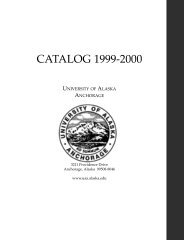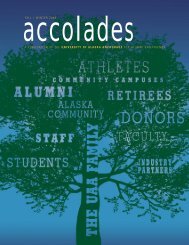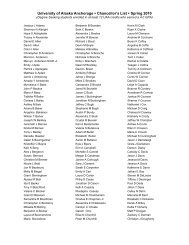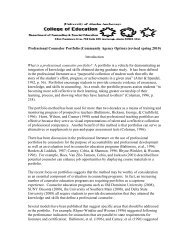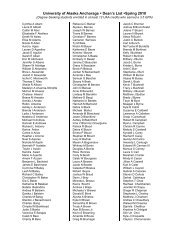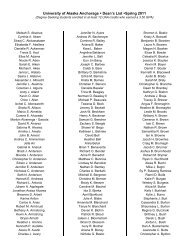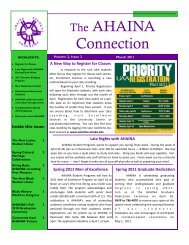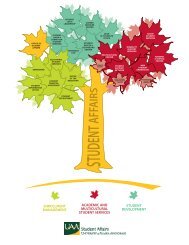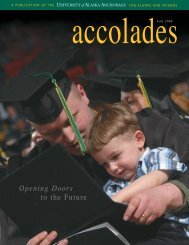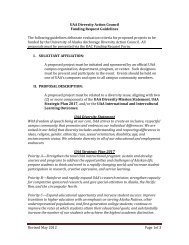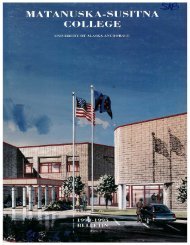UNIVERSITY OF ALASKA ANCHORAGE
UNIVERSITY OF ALASKA ANCHORAGE
UNIVERSITY OF ALASKA ANCHORAGE
You also want an ePaper? Increase the reach of your titles
YUMPU automatically turns print PDFs into web optimized ePapers that Google loves.
THE<br />
UAA<br />
COMMUNITY<br />
U<br />
Libby Roderick<br />
niversity of Alaska Anchorage program manager for the Center for<br />
Advancing Faculty Excellence Libby Roderick has spent years as a<br />
songwriter, performer, writer and activist, but it’s 42 words she penned for<br />
a friend in 1988 that have brought international acclaim to this<br />
life-long Alaskan.<br />
In recognition of her cumulative contributions, Rep. Ethan Berkowitz<br />
presented her with a citation from the 24th Alaska Legislature on Oct. 22.<br />
“Throughout her career, Libby Roderick has given back to Alaska and<br />
to her many causes through insightful songs, workshops, performances and<br />
commentaries as well as by her ever-present activism,” Berkowitz wrote in<br />
the citation.<br />
He said he’s known Roderick’s parents Jack and Martha Roderick since<br />
her father was the Greater Anchorage Borough Mayor from 1972 to 1975.<br />
“I picked her because she does good music for good causes,”<br />
Berkowitz said. “I’ve always liked her music.”<br />
Roderick is one of a handful of Alaska musicians who is as well known<br />
internationally as she is at home.<br />
Mostly, her notoriety centers on her signature song “How Could<br />
Anyone,” which has been translated into several languages and performed<br />
by countless groups worldwide.<br />
The hopeful anthem has generated so much buzz that in August 2005,<br />
CNN’s global news program Anderson Cooper 360 did a five-minute<br />
segment on the worldwide healing impact of her song.<br />
The Alaska Associated Press<br />
followed that with a story in September<br />
2005 that was picked up by media outlets<br />
ranging from the New York Times to<br />
ABC News and the Hindustani Times.<br />
The CNN story prompted Roderick to<br />
release a 10-song compilation CD titled<br />
“How Could Anyone.” It’s her sixth<br />
release, so far.<br />
Over the years she’s received hundreds<br />
of e-mails and letters from people<br />
telling their personal stories about how<br />
they are using the song.<br />
“We have bags full of letters and<br />
stories,” she said. “It just sort of took off<br />
all over the world.”<br />
Roderick said the song’s universal<br />
message of belonging has<br />
been used in every<br />
conceivable format and<br />
venue, from videos, films,<br />
and slide shows to hospitals, prisons, kindergartens, marches,<br />
peace gatherings, weddings, funerals and shelters.<br />
The simplistic three-minute song has just 42 words, but<br />
seems to contain the power to change hearts, Roderick said.<br />
“How could anyone ever tell you<br />
You were anything less than beautiful?<br />
How could anyone ever tell you<br />
You were less than whole?<br />
How could anyone fail to notice<br />
That your loving is a miracle?<br />
“How deeply you're connected to my soul.”<br />
“The message is people are beautiful and how can anyone<br />
tell them something else,” Roderick said.<br />
It speaks to a universal part of the human experience, she<br />
said. Everyone has felt like they are “less than” others at some<br />
time in their lives, Roderick said. More fame and fortune may<br />
be on the horizon for this Alaskan. She said the producer of<br />
the CNN piece wants to do a documentary about the impact<br />
“How Could Anyone” has had on people throughout the<br />
world. They are in conversations now with HBO to produce<br />
a documentary.<br />
T<br />
he Business Education Building, affectionately known as BEB and a<br />
UAA landmark, received a grown up new name in September -<br />
Edward and Cathryn Rasmuson Hall - honoring the Rasmusons for their<br />
matchless contributions to the University of Alaska, the state, and the<br />
community of Anchorage.<br />
Anchorage Mayor Mark Begich joined the Rasmusons, UAA<br />
Chancellor Elaine P. Maimon, UA President Mark Hamilton, and the UA<br />
Board of Regents at the re-naming ceremony.<br />
Ed Rasmuson, a prominent Alaskan banker, now retired, is the chair of<br />
the Statewide Advisory Board for Wells Fargo Bank and is also chair of<br />
the Rasmuson Foundation, established by his grandmother in 1955. The<br />
Foundation is one of the largest in the Northwest with $425 million in<br />
assets that fund arts and culture, health and human services, community<br />
development, and education efforts throughout Alaska.<br />
Community service is an important value for the Rasmuson family and<br />
both Ed and Cathy have served over many years on numerous boards and<br />
committees. Ed is only the second Alaskan recipient of the Boy Scouts of<br />
America Distinguished Scout Award recognizing Eagle Scouts who, after<br />
25 years, have distinguished themselves in their life’s work and in sharing<br />
their talents with their communities. He is the only individual to have<br />
served on the boards of all three of the state’s universities: the University<br />
of Alaska, Sheldon Jackson College, and Alaska Pacific University.<br />
Ed and Cathryn Rasmuson<br />
20 Accolades Accolades 21




